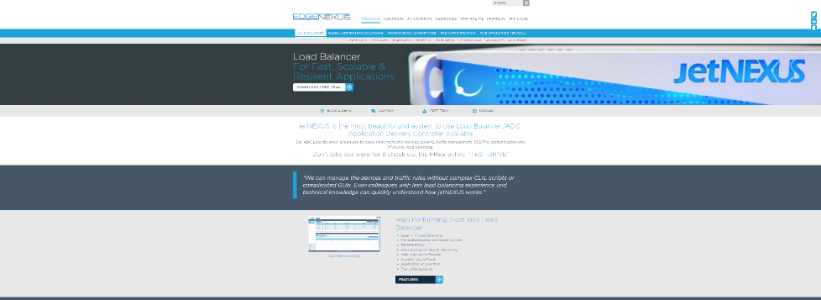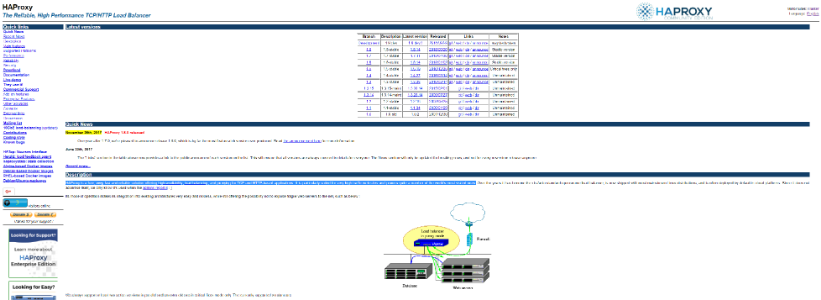Top 12 Server Load Balancing Software
What exactly is load balancing? In today’s fast-paced Internet world is not enough for companies and organizations to simply have a web portal to service their customers, members and visitors needs the Web portal must function at optimum speeds no matter what the demands or load placed on it is at any given time.
This is where load balancing comes in. System administrators can do their best to project one high-volume times will arise but without a plan to take the workload and spread it out amongst typically underutilized routers and servers your system will run slowly or even worse crash when the people logged on to your network needed the most. There was a time not long ago before the concept of load balancing even existed when people were content with Internet sites running slow crashing or not giving them optimum delivery during times of high volume usage, today this is simply unacceptable. If you want to keep your customers and visitors you must have a strategy in place to balance the load to matter how high the volume is at any given time.
Read More: Best Open Source Load Balancing Software
In the world of computer networking the phraseload balancing refers to the networks administrators ability to set up a scalable solution that will distribute the workload evenly across a minimum of two or more routers, servers, computers, CPUs, hard drives and any other resources you can think of that could help alleviate the burden placed on the network at that particular time.
Load-balancing is all about resource optimization and the maximization of workload throughput in order to minimize the networks response time and avoid overload or even the slightest slowdown for the networks and users. When it comes to load-balancing using multiple components with load-balancing is always better than trying to purchase a bigger and better single component the reason is quite simply scalability and redundancy.
Read More: Top 12 Remote Network Monitoring Software
There was once a time when network administrators could just keep buying larger and larger servers and faster and faster routers but that day is over the need is increasing at such a pace that network administrators must consider having multiple links in the chain in order to provide them with failsafe backups and scalability. Using this type of load-balancing technique you still achieve value from your older equipment and continue to add new equipment without having to replace your existing infrastructure. Load-balancing is about redundancy to load-balancing services usually provided by a dedicated program, application or device it typically involves things like a multilayer switch or a DNS server.
Load Balance Web Server
Web server balancing on web application server farms and server clusters. In regards to a load balance Web server, a server cluster is commonly defined as a group of Web servers running a web application simultaneously, this gives off an appearance to end-users as if they were accessing a single server. When it comes to load balance Web server balancing the system will distribute calls and service requests to various nodes within the cluster of servers with the load balance Web server working to optimize system performance. The utilization of a load balance Web server results in higher scalability server availability speed and reliability.
Read More: Top 9 Best Free and Open Source Firewall Software For Windows
In terms of load balance Web server definitions high availability is otherwise known as redundancy. What this means is if one server cannot handle the workload or a specific request the other servers in the cluster can step in and take over that task it is the job of the load balance Web server to determine which server within the cluster will handle which task in order to achieve optimum performance. Your mission as a network administrator when selecting a load balance Web server is to achieve what we refer to as a highly available system that gives the end-user a seamless fast and reliable experience no matter what server or combination of servers running simultaneously process their requests.
Read More: Top 15 Best Linux Server Monitoring Software
In terms of a load balanced Web server scalability is your system’s ability to support an exponentially growing number of end-users. This is a common problem with most enterprise networks suddenly and without warning the demands placed on your network outweigh the ability for your network to process the workload. Utilizing a load balance Web server can give you infinite scalability and would allow you to respond with ultra fast response times no matter how many concurrent requests are made on your system.
Read More: The Top 10 Rated DDoS Attack Protection Services Providers
Two types of load balancing efforts we will now look at are DNS round-robin and hardware load balancer’s.
A load balance Web server can be utilized in the DNS. round robin environment. The main advantage of establishing your load balance Web server in a round-robin is that it is inexpensive and extremely easy to set up. As a system administrator, you only need to make a few changes in the DNS to support round-robin. Many of the newer servers already include support for the round robin environment.
Hardware load balancer’s are another way to solve many of the problems faced by the round-robin software solution. A hardware load balancer shows a single button virtual IP address to the outside world which maps to the various addresses of each server within your network’s cluster. Therefore the load balancer exposes the IP address of the entire cluster globally.
Read More: Top 16 Best Web Application Firewall (WAF) Vendors
Top 12 Server Load Balancing Software:
BARRACUDA
Barracuda Load Balancer ADC optimizes network traffic distribution for greater application and website performance, all while providing protection from an ever-expanding list of cyber threats.

BARRACUDA
KEMPTECHNOLOGIES
Since 2000 The # Price/Performance Load Balancer starting at $1,990 – Free Trial Download. Over 20,000 users

KEMPTECHNOLOGIES
EDGENEXUS
Edgenexus ADC Load Balancer allows you to easily implement and manage security, traffic management, SSO/Pre-authentication and, of course, load balancing.

EDGENEXUS
HAPROXY
HAProxy is a free, very fast and reliable solution offering high availability, load balancing, and proxying for TCP and HTTP-based applications. It is particularly suited for very high traffic web sites and powers quite a number of the world’s most visited ones.

HAPROXY
TERMINALSERVICEPLUS
TSplus is the Best Remote Desktop Software and alternative to Citrix/TSE. Available on SBS, XP, W7, W8, Winwdows 2003 and 2008. Free download from the web.

TERMINALSERVICEPLUS
DYN
Web applications are the new standard for businesses. Ensure that your business is safe from cyber attacks, malicious bots, and DDoS attacks. Learn how Oracle Dyn can help achieve the highest level of security for your web applications and provide world class DNS for your website.

DYN
AVINETWORKS
The Avi Vantage Platform delivers a 100% software approach to application services with Software Load Balancers, Intelligent WAF (iWAF) & Elastic Service Mesh.

AVINETWORKS
SNAPT
Snapt ensures your website is always online, performing quickly and safe from threats. We provide load balancing, acceleration and security for critical services.

SNAPT
NGINX
NGINX accelerates content and application delivery, improves security, facilitates availability and scalability for the busiest web sites on the Internet.

NGINX
RADWARE
Continuously adaptive real-time DDoS services for the most sophisticated web security threats through best-in-class cloud WAF and DDoS protection technologies.

RADWARE
ARRAYNETWORKS
Array is a leader in application delivery networking with over 5000 worldwide customer deployments addressing secure delivery of applications to end users.

ARRAYNETWORKS
TOTALUPTIME
Total Uptime is a premium Cloud Service Provider offering Cloud DNS, Cloud Load Balancing, Web Application Firewall and other solutions using its own global cloud platform.

TOTALUPTIME
load balancer
Why is the load balancer so important to network administrators today because without it there system may run perfectly one minute and drive all of their visitors away the next. Without the proper strategy in place to deal with unpredictable demands on the network and trying to maximize throughput in a matter what the demands are at any given time and some sort of load balancer in place a network administrator is going to be looking for a job in no time. A load balancer is critical to make sure that your users do not notice the demands placed on the network by other users during their visit to your web portal.
Using a load balancer means you’re following a process in which all inbound Internet protocol or IP traffic is distributed using the load balancer across multiple servers. Load balancer’s are designed specifically to enhance the performance of your servers and help you achieve optimal utilization, redundancy and failsafe measures. When a load balancer is in place if one server fails the load balancer can step in and re-route that workload to a server ready to take on the responsibility.
Typically a load balancer is implemented with at least two or more Web servers creating up the load balancing scheme by utilizing a load balancer the service time is reduced by using it to identify which server has the appropriate ability to receive the current incoming traffic to your network.
People tend to get overwhelmed when I think of purchasing a load balancer but the process is fairly easy and straightforward. When a load balancer is in play a webpage request is sent to it and it forwards the request to one of your servers that is ready and online and can take on the workload. A load balancer can often help tremendously when you have periods of server downtime due to either a server failure or your regularly.
Scheduled server maintenance, with a load balancer in place you can reroute jobs during these critical times. Some organizations are long enough to employ scattered server farms and load balancer’s play a key role in selecting which servers in the geographical cluster should do which jobs this process is often referred to as global server load balancing or GSLB.
Now more than ever purchasing a load balancer is affordable and a solid investment for your network as a load balancer allows you to not have to constantly replace hardware and gives you the ability to daisy chain old servers together in order to maximize performance without having to buy a new faster server. Many network administrators are discovering how wonderful it is to use old servers in a server farm or server cluster and have a load balancer do the work of distributing throughput broader than employing huge budgets to purchase a new server or servers.
Load Balancing Systems
When it comes to achieving total network performance network administrators must turn to load balancing systems. No network administrator has an unlimited IT budget for purchasing new servers and even if they did, there would come a time when they would need to institute load balancing systems to achieve proper network productivity and response times.
In the world today, data centers are evolving into virtualized environments were system optimization and resource utilization must be maximized. Load-balancing systems provide other advantages such as reducing cost and power dissipation. In order to optimize the use of these environments advanced load-balancing techniques must be utilized by system administrators.
Some of the key areas of load-balancing systems are resource optimization, performance, security, and failure recovery.
Load-balancing systems are systems that are designed to evenly distribute workload across a multitude of computers networks and network clusters in order to achieve optimal utilization and user experience without the risk of creating bottlenecks or single points of failure. If a single server is designated to perform a task within the network and that server fails a load-balancing system can step in and redistribute that workload to a currently available server within the network or network cluster. The use of multiple components when it comes to load-balancing systems instead of a single component will typically increase the reliability through redundancy. A load-balancing system is usually designed to direct workload to hardware devices by utilizing a dedicated program or hardware device.
One common use of load-balancing systems is to mediate internal communications within a network computer cluster especially those that require uncompromised availability and 100% guaranteed uptime. Like we addressed before when it comes to load-balancing systems if the load is more on one server within the cluster than the load-balancing system will call upon secondary servers to take the workload while the initial server is still processing requests.
Features of load balancing systems:
load-balancing systems often use asymmetric load, this is a ratio that can be manually assigned so that certain servers within the cluster share the workload of others.
Load-balancing systems often times utilize priority activation. Priority activation is when the number of available servers or server clusters drops below a minimum required number or the workload on the given network moves higher than a maximum amount allowed standby servers are then brought online.
SSL offload and acceleration is a huge task for load-balancing systems. SSL applications are some of the most difficult applications and can place a heavy burden on the resources of any particular Web server. If the Web server is overworked the end-user will generally start to receive slower than optimal response times from the Web server a load-balancing system is capable of handling SSL offloading and reducing the burden of increasing the performance of Web servers with in the network.
Clustering Load Balancing
Clustering load balancing, what does all this mean? You are a network administrator in your organization is weighed down with demands on your existing network and server farm, in an effort to speed up network performance you are thinking about using clustering load balancing to design and modify your current infrastructure tier to improve and maintain performance and give you the ability to adapt to the changing demands placed on your network. The problem when selecting clustering load balancing as a solution to improve infrastructure is how do you go about designing a scalable infrastructure tier that handles the extreme variability in load while maintaining your desired level of performance? Let’s look at the forces behind this problem in a little more detail and discuss how clustering load balancing can help.
When it comes to clustering load balancing individual servers all have a maximum amount of load capacity and speed for all applications clustering load balancing helps ensure that each individual server is at operating close to maximum performance without being overburdened.
In regards to clustering load balancing individual servers have a maximum physical performance as well. These physical limitations include limitations on the speed of the server limitations on the performance of the bus as well as the amount of memory, the number of peripherals that you can use with the server and the number of processors running the server.
When looking at clustering load balancing we must also take into account that certain applications have limitations on the number of CPUs that can be used with those applications.
Network administrators designing a clustering load balancing solution must also take into account the fact that servers designed as standalone individual entities individual entities open door to single points of failure. If a network administrator is not using clustering load balancing and only one server is responsible for providing the functionality behind an application across the network that servers failure will cause the entire application to fail across the network.
Clustering load balancing is the solution. When a network administrator designs and installs any service or application over multiple servers that are configured to share the workload this type of configuration is referred to as clustering load balancing. Clustering load balancing gives network administrators the ability to distribute in scale the performance of many or all server-based applications by distributing client request across the networks wide array of multiple servers. Clustering load balancing configurations and technologies are sometimes also referred to in the industry as load balancing switches, load balancer’s and network load-balancing applications. Clustering load balancing gives you the ability to receive incoming requests and route them to a specific host or server as necessary to distributing the workload and increasing the speed, performance and capabilities of your network without the need to purchase additional servers or bandwidth.
Firewall Load Balance
Firewall load balance gives a network administrator the ability to configure multiple firewalls to overcome performance setbacks and limitations and remove the threat of having a single point of failure when all traffic is bottle necked and forced through your networks single firewall. If firewall load balance ensures the network administrator and the network will forward packets with the same source and destination IP addresses through the same firewall. The firewall load balance can accomplish this mission by performing a high level XOR on both the destination and source IP addresses.
Firewall load balance can exist on either side of the firewall what we mean is firewall load balance can balance traffic over a host of firewalls simultaneously. Therefore each of your network firewalls is active and available by utilizing a firewall load balance algorithm. It is very important to note that firewalls themselves do not have the ability to administer or perform network address translation. This means that if your current network configuration demands that you perform network address translation you must configure a content rule or source group to provide this functionality.
To achieve firewall load balance the network administrator should first layout and define the following parameters for every path through their network’s firewall this includes both local and remote firewall paths.
The first parameter that should be defined to achieve firewall load balance is a firewall index. The firewall index identifies the physical firewall as well as local firewall IP addresses and all remote firewall IP addresses.
The second parameter that should be defined in order to achieve firewall load balance is the static route that the CSS will use for each individual firewall.
Configuring a firewall load balance. In order to configure a firewall load balance the network administrator must utilize the IP firewall command to define each of their firewall parameters. The network administrator must then define these parameters for each path through their network firewalls for both local firewalls and remote CSS’s.
In order to reach a firewall load balance a CSS should always exist on both sides of the network’s firewall to control which of the network firewalls is selected for an individual workflow. When you are designing the firewall configuration the network administrator should always configure the remote and local CSS’s with the same firewall index number.
Personal contact info – slikgepotenuz@gmail.com
Permanent Address :- Montville, NJ
CEO and co-founder at Cloudsmallbusinessservice.com